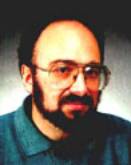An Interview with Dr. Igor B. Roninson
by Mr. LTC
CNN -- Scientists said Monday they have discovered a master gene that appears to contribute to development of cancer, hardening of the arteries, arthritis, Alzheimer's disease and other diseases associated with aging. Chemically targeting this single gene, known as "p21," could prevent or combat many diseases of aging, the scientists from the University of Illinois at Chicago reported in a professional journal, Proceedings of the National Academy of Sciences.
Paradoxically, p21 inhibits growth of about 40 additional genes and increases activity of about 50 others. This process is similar to what occurs with cancer, said Igor Roninson, senior author of the study and professor in the university's department of molecular genetics.
A "Mr. LTC" Interview

Dr. Igor B. Roninson
University of Illinois at Chicago
College of Medicine
Distinguished University Professor
Head, Division of Molecular Oncology
PhD, Massachusetts Institute of Technology
Rhoads Memorial Award, American Association for Cancer Research,
1994.
MERIT Award, National Cancer Institute, 1993.
Faculty Research Award, American Cancer Society, 1989
Mr. LTC: How many years have you been working on this project?
Dr. Igor Roninson: About two years.
Mr. LTC:What was the origin of the p21 project? Please tell us the story.
Dr. Igor Roninson: My primary research area is cancer research. We were studying how cancer drugs act on tumors, and we found that different anti-cancer agents and radiation have an effect that wasn't described before us, and this effect is to make tumor cells look the way old senescent cells look and stop their growth, the way old senescent cells do. So we were studying how anti-cancer drugs do that, and we knew that one of the critical regulators of cell growth is a gene called p21, which acts as a brake that stops cell growth in response to damage as well as in the course of senescence.
We knew that p21 is a common regulator of growth, and we asked if 21 also plays a role in the in the induction of senescence by anti-cancer drugs.
We found that it did, and that it is one of the key regulators of this response in tumor cells. We also knew that anti-cancer drugs induce p21. They cause damage, and then p21 expression goes up. So we asked if this increase in p21 expression is sufficient by itself to make tumor cells appear senescent . We made an artificial genetic system where we could turn p21 on without damaging the cell, just by using purely genetic tricks to turn it on and then we can turn it off again.
We found that when we turned p21 on, cells stopped growing, which was exactly what we expected them to do, and they also started looking senescent. Then we asked, how does p21 do that?
We used a new methodology that became available in the last couple of years, it's called a cDNA Array Hybridization, and with this methodology, we can look simultaneously at more than 7,000 genes.
We asked, which of them are turned on or turned off when we do something to the cell?
And in this case what we did to the cell was to turn p21 on. We saw very clear patterns: when we looked at the genes that were turned off when we turned p21 on, we found that the majority of these genes were involved in cell division. And in fact, if we kept p21 on for a while and then turned it off, the cell division genes that were inhibited by p21 would be turned on again, but often, not very efficiently, and what we saw when we turned p21 off was that some of the cells divided abnormally. That was all very important because such abnormal cell division may contribute to the development of cancer, and also this is something that's known to happen in cells of older people. In fact, there was a recent that said that this abnormal cell division may be one of the key events in undesirable consequences of aging at the cellular level.
The we looked at the genes that are turned on after we turned p21 on and we saw a number of things that were surprising to us. First of all, as I said, when we turned p21 on, cells stopped growing, but among the genes that were up-regulated in these cells, we saw those that give rise to proteins that come out of the cells and stimulate the growth of other cells, or protect them from dying. In other words, cells stop growing, and they give a push to their neighbors to proliferate. That is something that actually is happening in cancers; there are some cells in tumors that provide these growth factors, this stimulating activity to other cells in the tumors, and as a cancer researcher, I know that this is a very important part of tumor development and tumor growth.
So that suggested to us, first of all, that one of the consequences may contribute to the development of cancer. Then, when we were looking at other genes and what they do, we saw a number of genes that were actually known to be overproduced in cells that undergo senescence in cell culture and also in aging individuals. And among these genes, we saw approximately twelve that were known to play a role or to be indirectly associated with several age-related diseases, including Alzheimer's Disease, atherosclerosis, and arthritis. In fact, it was groups of genes that were up-regulated by p21 that have been implicated in these diseases. That suggested that p21 induction, which may occur repeatedly over our lifetime, (depending on how much damage we experience, because p21 is turned on by damage, damage that may come from radiation or toxins) and also p21 is turned on when the cells of our body undergo their last cell division and stop growing for good, it's possible that over production of these proteins may contribute to the development of cancer and Alzheimer's, and atherosclerosis and arthritis. It's certainly not the only cause, but it is potentially one the causes.
Mr. LTC: What was the most surprising thing you found in this research?
Dr. Igor Roninson: Probably to me the most surprising thing was finding the proteins that have a growth-stimulatory and death-supressing activity for other cells. In fact, if anything, I expected the opposite. The only function of p21 that was know is stopping cell growth and this is what we saw at the level of genes that are down-regulated by p21. I actually expected that I would also see some growth-arrest genes to be turned on, but instead what we saw was turned on were genes for proteins that stimulate cell growth, but they do it in other cells.
Mr. LTC: What implications for research does this discovery have?
Dr. Igor Roninson: Well, this is a whole new direction of research for us because we did not expect p21 to be positively associated with cancer or Alzheimer's or atherosclerosis. And we have a very nice cellular system where we can turn these events on and off at will, and we can also easily mirror these events, so that allows us to use this cell system as the tool to search for drugs that would prevent these downstream effects of p21 and once we have such compounds that inhibit the effects of p21 we can investigate if these compounds may be of any use in the treatment of cancer or in slowing down the development of age-related diseases.
Mr. LTC: Is this cellular system unique to your lab only, or is this something that other cancer research labs can do?
Dr. Igor Roninson: Right now it's in our lab only, but the way things work in academic research, we will be glad to share it with other academic researchers. Companies that may want to use it will have to obtain a license from our university, but academic researchers share their materials with each other.
Mr. LTC: Have you been contacted by any companies wishing to use this research?
Dr. Igor Roninson: No, our paper just came out today, and the media release was yesterday. I wouldn't have anticipated any such action yet.







